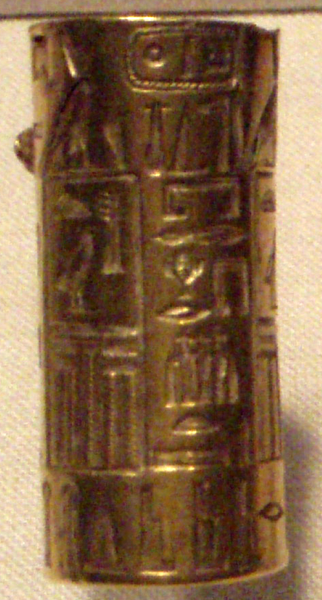Dyedkara Isesi - Español
De Wikipedia, la enciclopedia libre
Dyedkara Isesi fue el penúltimo faraón de la dinastía V de Egipto de c. 2380 a 2342 a. C. (von Beckerath).
Manetón, según Julio Africano, le llama Tankeres y le atribuyó 44 años de reinado. Según el Canon de Turín, Dyedy, gobernó 28 (o 38) años. Lo encontramos como Dyedkara en la Lista Real de Abidos y como Maatkara en la Lista Real de Saqqara.
No se conoce bien su parentesco. Probablemente su padre fue Menkauhor, se casase con Meresanj IV y sus hijos fueran Isesianj, Raemkuy y posiblemente Unis.
- Dyedkara limitó el poder del único gran chaty (el de Menfis) creando un nuevo cargo, el de chaty del Sur para el Alto Egipto.
- Siguió con la actividad minera en la zona de Uadi Maghara (Sinaí) y Asuán.
- Continuó con la política de relaciones diplomáticas con Biblos y Nubia. Organizó una expedición al país de Punt.
Contenido |
Construcciones de su época [editar]
Mandó erigir su complejo funerario en Saqqara, conformado por:
- La pirámide (altura original 52’5 m, base 78’5 m, pendiente 53º 7’ 48”) con antecámara, una sala de almacenaje, serdab, y cámara funeraria con el sarcófago de gres negro (destruido), donde se encontró una momia de unos 50 años, tal vez de Dyedkara.
- El templo de la pirámide constaba de un patio abierto, porticado, con columnas de granito y capiteles palmiformes, un gran salón, la sala de ofrendas y almacenes. Se encontraron fragmentos de relieves y de estatuas de prisioneros extranjeros, y de animales.
- El templo del valle, someramente investigado.
- Una pequeña pirámide de una reina con un templo funerario.
La tumba de la reina Meresanj IV se encuentra en Saqqara, las tumbas de sus hijos y de sus oficiales, en Abusir.
Titulatura [editar]
| Titulatura | Jeroglífico | Transliteración (transcripción) - traducción - (procedencia) |
| Nombre de Horus: |
| ḏd ḫˁ u (Dyedjau) Estable en las apariciones |
| Nombre de Nebty: |
| ḏd ḫˁ u (Dyedjau) Estable en las apariciones |
| Nombre de Hor-Nub: |
| ḏd (Dyed ) Estable |
| Nombre de Nesut-Bity: |
| ḏd k3 rˁ (Dyedkara) Estable es el espíritu (Ka) de Ra (Lista Real de Abidos nº 32) |
| Nombre de Sa-Ra: |
| i s s i (Isesi) Isesi, hijo de Ra |
Referencias [editar]
- Bibliografía
- Sethe 1933. Kurt Sethe. Urkunden des Alten Reiches. I. Leipzig
Enlaces externos [editar]
 Wikimedia Commons alberga contenido multimedia sobre Dyedkara Isesi.
Wikimedia Commons alberga contenido multimedia sobre Dyedkara Isesi.
 Wikiquote alberga frases célebres de o sobre Las máximas de Ptahhotep, visir de Dyedkara Isesi.
Wikiquote alberga frases célebres de o sobre Las máximas de Ptahhotep, visir de Dyedkara Isesi.- Dyedkara Isesi, en egiptomania.com
| Predecesor: Menkauhor-Ikauhor | Faraón Dinastía V | Sucesor: Unis |
Categorías: Faraones | Dinastía V
Djedkare Isesi - Inglés
From Wikipedia, the free encyclopedia
| Djedkare Isesi | ||||
|---|---|---|---|---|
| Tankeris | ||||
 | ||||
| Gold cylinder seal bearing the names and titles of the pharaoh Djedkare Isesi. | ||||
| Pharaoh of Egypt | ||||
| Reign | 2414–2375 BC, 5th dynasty | |||
| Predecessor | Menkauhor Kaiu | |||
| Successor | Unas | |||
| Died | 2375 BC | |||
Djedkare Isesi in Greek known as Tancheres[1] from Manetho's Aegyptiaca, was a Pharaoh of Egypt during the Fifth dynasty. He is assigned a reign of twenty-eight years by the Turin Canon although some Egyptologists believe this is an error and should rather be thirty-eight years. Manetho ascribes to him a reign of forty-four years while the archaeological evidence suggests that his reign is likely to have exceeded thirty-two years. His prenomen or royal name—Djedkare—means "The Soul of Ra Endureth."[2]
Djedkare Isesi did not, as was customary for his dynasty, build his own sun temple, but did build his pyramid at Saqqara instead of Abusir. This is believed to be a sign that Osiris had now replaced the sun-god Ra as the most popular god. Titles were now thought to hold magical power; their growing importance believed to be a sign of a gradual decentralization of power.
An entire series of dated administrative papyri from Djedkare's reign, (the Prisse Papyrus at the Louvre, authored by Ptah-hotep), was discovered in king Neferirkare's mortuary temple. According to Miroslav Verner, Djedkare Isesi's highest known date is a Year 22 IV Akhet day 12 papyrus,[3] which would belong anywhere from Year 32 to Year 44 of his reign depending on whether the Cattle Count was Bi-annual (2 times) or semi-annual (1.5 times).

Djedkare Isesi's reign is well documented both by the Abusir papyri as well as by numerous royal seals and contemporary inscriptions; taken together, they indicate a fairly long reign for this king.[4]
His almost complete mummy, along with a badly broken basalt sarcophagus and a niche for the canopic chest, was discovered in his damaged pyramid tomb at Saqqara.
[edit] See also
[edit] References
- Miroslav Verner, Archaeological Remarks on the 4th and 5th Dynasty Chronology, Archiv Orientální, Volume 69: 2001, pp. 405-410 (coverage of Djedkare Isesi's reign)
[edit] External links
- Egyptian Kings
- The Instruction of Ptahhotep Index Page (Prisse Papyrus)
- The Mastaba of Ptahhotep reliefs from his tomb (Prisse Papyrus)
This article about Egyptology or subjects relating to Ancient Egypt is a stub. You can help Wikipedia by expanding it. |
En otros idiomas
- Català
- Česky
- Deutsch
- English
- Euskara
- Français
- Hrvatski
- Italiano
- 한국어
- Lietuvių
- Nederlands
- Polski
- Português
- Română
- Русский
- Srpskohrvatski / Српскохрватски
- Svenska
- 中文
| | Fotos de |
Creta











![M17 [i] i](http://es.wikipedia.org/w/extensions/wikihiero/img/hiero_M17.png)




















No hay comentarios:
Publicar un comentario